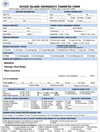The Impact of Incomplete Nursing Home Transfer Documentation on Emergency Department Care
- PMID: 30385229
- PMCID: PMC6996106
- DOI: 10.1016/j.jamda.2018.09.008
The Impact of Incomplete Nursing Home Transfer Documentation on Emergency Department Care
Abstract
Objectives: Emergency department (ED) clinicians rely on the accuracy of written communication when assessing needs of nursing home (NH) residents. This study aimed to review the completeness of NH transfer documentation according to expected core components, as guided by the INTERACT 4.0 quality improvement tool. We also describe the association between patient or facility characteristics and transfer documentation completeness, as well as establish whether information gaps in NH-ED transfer documentation were associated with hospital admission.
Design: Retrospective study using 2 abstractors blinded to the study aims.
Setting and participants: 474 records from NH residents transferred to the 3 EDs of Rhode Island's largest health care system from September 2015 to September 2016.
Measures: NH-ED transfer documentation completeness was reviewed according to the expected core items of transfer documentation, guided by the INTERACT 4.0 quality improvement tool. We used multivariable linear regression with random effects to assess factors associated with NH-ED transfer documentation completion and logistic regression with random effects to assess the relation between information gaps and hospital admission.
Results: Of the 474 NH-ED transfer visits, mean patient age was 76 years; 43% were male, 14% were nonwhite, and 34% had dementia. NH-ED transfer documents were present for 97% of visits, and an average 11.9 of 15 INTERACT core items were complete. Usual mental status and reason for transfer were absent for 75% of patients, whereas functional status was absent for 80%. The multivariable model showed that a higher Charlson Comorbidity Index score (coefficient 0.08, standard error 0.04, P = .03) was associated with more complete documentation. More complete documentation was associated with greater likelihood of hospital admission (adjusted odds ratio = 1.09, 95% confidence interval = 1.01-1.18).
Conclusions/implications: Usual mental and functional status and the reason for transfer are often missing in NH-ED transfer documents and should be incorporated into standardized transfer forms.
Keywords: Transfer documentation; dementia; emergency department; nursing home.
Copyright © 2018 AMDA – The Society for Post-Acute and Long-Term Care Medicine. Published by Elsevier Inc. All rights reserved.
Conflict of interest statement
The authors declare no conflicts of interest.
Figures
Similar articles
-
Identifying Potentially Preventable Emergency Department Visits by Nursing Home Residents in the United States.J Am Med Dir Assoc. 2015 May 1;16(5):395-9. doi: 10.1016/j.jamda.2015.01.076. Epub 2015 Feb 18. J Am Med Dir Assoc. 2015. PMID: 25703449 Free PMC article.
-
A Retrospective Analysis of Nursing Home to ED Transfer Correspondence Length and ED Length of Stay.R I Med J (2013). 2019 Nov 1;102(9):29-32. R I Med J (2013). 2019. PMID: 31675784 Free PMC article.
-
The nursing home effect: a case study of residents with potential dementia and emergency department visits.J Am Med Dir Assoc. 2013 Dec;14(12):901-5. doi: 10.1016/j.jamda.2013.08.010. Epub 2013 Sep 29. J Am Med Dir Assoc. 2013. PMID: 24083982
-
Appropriateness of transferring nursing home residents to emergency departments: a systematic review.BMC Geriatr. 2019 Jan 21;19(1):17. doi: 10.1186/s12877-019-1028-z. BMC Geriatr. 2019. PMID: 30665362 Free PMC article.
-
Age and sex differences in emergency department visits of nursing home residents: a systematic review.BMC Geriatr. 2018 Jul 3;18(1):151. doi: 10.1186/s12877-018-0848-6. BMC Geriatr. 2018. PMID: 29970027 Free PMC article.
Cited by
-
End user information needs for a SMART on FHIR-based automated transfer form to support the care of nursing home patients during emergency department visits.AMIA Annu Symp Proc. 2021 Jan 25;2020:1239-1248. eCollection 2020. AMIA Annu Symp Proc. 2021. PMID: 33936500 Free PMC article.
-
Sociotechnical feasibility of natural language processing-driven tools in clinical trial eligibility prescreening for Alzheimer's disease and related dementias.J Am Med Inform Assoc. 2024 Apr 19;31(5):1062-1073. doi: 10.1093/jamia/ocae032. J Am Med Inform Assoc. 2024. PMID: 38447587 Free PMC article.
-
Age-related differences in symptoms in older emergency department patients with COVID-19: Prevalence and outcomes in a multicenter cohort.J Am Geriatr Soc. 2022 Jul;70(7):1918-1930. doi: 10.1111/jgs.17816. Epub 2022 Apr 29. J Am Geriatr Soc. 2022. PMID: 35460268 Free PMC article.
-
Nursing Home to Emergency Care Transition Form Has Limited Uptake But Improves Documentation.J Am Med Dir Assoc. 2024 Aug;25(8):105056. doi: 10.1016/j.jamda.2024.105056. Epub 2024 Jun 4. J Am Med Dir Assoc. 2024. PMID: 38843872 Free PMC article.
-
A first look at consistency of documentation across care settings during emergency transitions of long-term care residents.BMC Geriatr. 2023 Jan 11;23(1):17. doi: 10.1186/s12877-023-03731-6. BMC Geriatr. 2023. PMID: 36631759 Free PMC article.
References
-
- Nelson D, Washton D, Jeanmonod R. Communication gaps in nursing home transfers to the ED: Impact on turnaround time, disposition, and diagnostic testing. Am J Emerg Med 2013;31:712–716. - PubMed
Publication types
MeSH terms
Grants and funding
LinkOut - more resources
Full Text Sources
Medical




